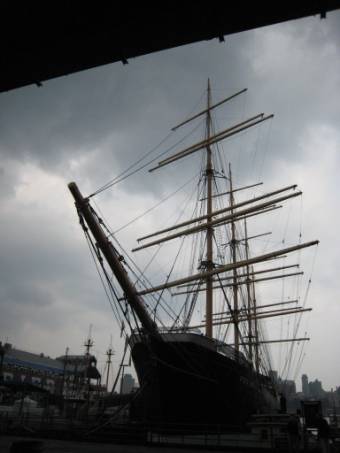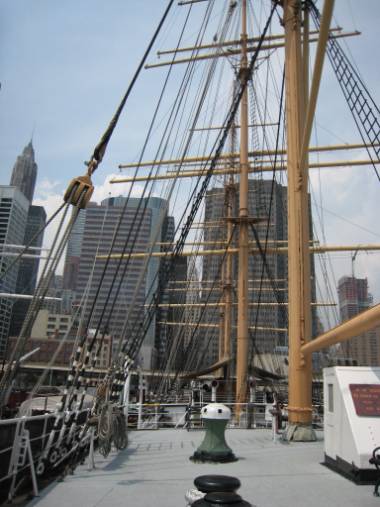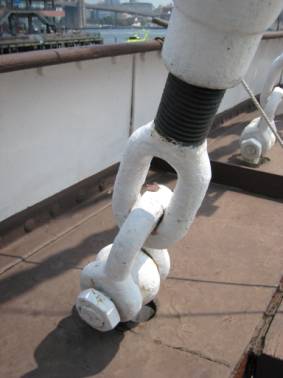RALPH, ALBERT & SYDNEY
TELLING TALES
An occasional series exploring the stories behind Ralph McTell's discography.
Keith Littlechild tells of his visit to the ship which sailed 'Around the Wild Cape Horn'.
|
The 'Peking'
|
From the time I first heard it I’ve been captivated (and, on occasion hypnotised) by Ralph’s stirring, poignant and life affirming song describing Irving Johnson’s incredible 1920’s voyage around Cape Horn. To be strictly accurate this was sometime before the end of the second verse; St Mary’s Church in Banbury, just prior to Ralph’s 60th Birthday Concert in 2004.
Some of you will understand why this is so and probably also know that Ralph’s ingenious word arrangements don’t just fall on to the page as he takes the cap off his pen. I know he works incredibly hard to arrive at the finished songs which have touched many of us personally in some way over the years and ‘Around the Wild Cape Horn’ is no exception.
It was written after Ralph had seen the grainy B&W silent film footage, taken by Irving Johnson as a 20-year-old on board the last of the big sailing ships. He later added the commentary when in his 80’s.
I hadn’t seen the film but had early on checked some of the phenomenal numerical information contained in the song and was delighted, although not entirely surprised, to find it all so accurate. ‘An acre of sail...’ might sound like poetic licence but...
1 acre = 70yd x 70yd = 4,900 sq yd; 1 sq yd = 9sq ft; 4,900 x 9 = 44,100 sq ft; Peking Sail Area = 44,132 sq ft
|
The opportunity of a short-notice trip to Pennsylvania arose in August 2009; my first outside of Europe. I had little time to prepare or plan anything but getting to see the ‘Peking’ at the South St. Maritime Museum in New York was achievable and not least on my list.
Given the significance of the exhibit in their collection I imagined they would have somehow known about or heard the song. But what if they hadn’t? It seemed important, so I went prepared.
Following a 3-hour Amtrak journey from Malvern PA I arrived at South St via the subway train from New York Central on Wednesday at about 1pm. It was hot, about 92ºF, and very humid. The ‘Peking’ was alongside the quay and could not be mistaken. She is huge, both in length and height and beyond anything I had imagined. The bowsprit was close to and on the same level as the adjacent overpass, so it was almost impossible to get far enough back to get all the ship in shot. I paid my $8 and couldn’t wait to get aboard and explore.
|

|

|
None of the staff I asked had heard about Ralph’s song and the Museum are not currently running Irving Johnson’s film, as they have in the past, although this is about to change.
The sole chap manning 'Peking', Steven, was extremely interested to learn that a song about the ship had been written and also was very familiar with the story, via the film, but couldn't desert his post. I continued my exploration of the ship, above and below decks, and felt a sense of awe for the sailors who endured the cramped conditions for 3-month stretches. There were no 80-foot waves available on that Wednesday for me to gain a true appreciation of their experience, and the deck remained firmly horizontal.
|
|
The sheer size of the complex rigging fixtures and myriad of ropes and cables to raise, lower and secure 32 enormous sheets of canvas, each weighing over a ton, was breathtaking.
|
|
The dime coin illustrates the comparative size of this shackle and the attached turnbuckle is about a metre long.
Back at the Museum I learned that the Historian was on leave, Wednesday was the Curator's day off and there was nowhere to play the single track CD I'd brought with me. I sensed something of how Brian Epstein might have felt at Decca Records.
Nevertheless the remaining staff were unfailingly helpful and with their promise to try to contact someone in a position to judge if the song might in some way add to the ‘Peking’ experience, I set out in the direction of the nearby Twin Towers site to pay my respects and to see what I could of New York before returning late afternoon in the hope that they had succeeded.
It wasn’t to be and somewhat disappointed, I said my farewells to Steven and made my way towards the exit. As I did so a young woman came out of the Marine Operations part of the museum. I explained about the song, she seemed keen to hear it and gave me her card. Still no access to CD player but I realised my iPod was in my rucksack, but minus the necessary headphones. I went in search of some about 25 minutes before closing. It was unlikely I'd find an audio shop nearby and get back in time but my luck continued and I was back in 15.
I hadn't had chance to read the card at the time so didn't fully appreciate she was probably the person most qualified, in both senses, for me to meet. I subsequently learned the true significance of her position; she's Master of a 60-ton, 125-ft Schooner built in 1893, which is used as sail training for young people off the Northeast seaboard.
The pictures give some indication of how well Ralph’s song was received by those who listened intently to the 6-minute saga and they all enthused wildly about it during and after. Apart from the photo of Steven on the ‘Peking’ earlier in the day they are un-posed and none of us knew they were going to be taken. I'm glad it occurred to my spare hand to get camera out of rucksack once it became obvious they were all well into it.
|
|

|

|
|
To find people with first hand experience of sailing ships of the same vintage as ‘Peking' and all that entails, willing to listen, was completely unexpected. The young woman on the right of picture is Denise, Master of the Schooner, and that on the left, the Bosun. The song had, in a sense, found its way home and there is now the possibility that it will be heard in that setting.
The rest of my trip, including the Civil War site at Gettysburg, Martin Guitar factory at Nazareth PA and the Smithsonian Air & Space Institute near Washington, where a ship of a different century, the Space Shuttle, also greatly impressed with its physical size and significance of its voyage, could not eclipse my experience at the South St.Seaport Maritime Museum.
Since my return I’ve seen Irving Johnson’s film, courtesy Mystic Seaport’s excellent service. I’m glad to have done so in reverse of what is probably the usual sequence as it brought home the true enormity of the voyage and undoubted courage having seen first hand the most rudimentary equipment at their disposal. It also confirmed the authenticity with which Ralph conveyed the dramatic content and spirit of a 35-minute visual documentary in words and music lasting a sixth of that time and, for me, this is a real testament to his ability as a songwriter.
Keith Littlechild. August 2009
Footnote: I’ve also often wondered whether Bob Dylan has heard Ralph’s versions of his songs. I passed through New Jersey and if I'd known Bob was there at the time (feeling like a complete unknown) I’d have taken ‘Travelling Man’ too. Unlike the policewoman about to charge Mr Dylan for vagrancy, I like to think I’d have recognised him, bought him a cup of tea and let him hear ‘Girl from the North Country’ as we know it!
|
An edited version of this article appeared in Ralph's Autumn 2009 newsletter.
Thanks to Ralph and Leola Music Ltd for allowing us to publish the full tale here.
Neither Ralph nor Leola Music Ltd had any prior knowledge of Keith's trip or of his intention to visit the 'Peking'.
All illustrations are the copyright of their owners or publishers and are reproduced here for information only.






